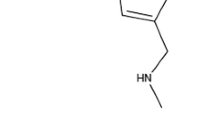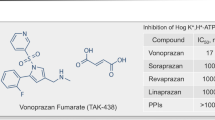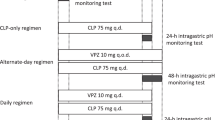Summary
Famotidine is a potent histamine H2-receptor antagonist widely used in the treatment and prevention of peptic ulcer disease. After intravenous administration the plasma famotidine concentration-time profile exhibits a biexponential decay, with a distribution half-life of about 0.18 to 0.5h and an elimination half-life of about 2 to 4h. The volume of distribution of the drug at steady-state ranges from 1.0 to 1.3 L/kg; plasma protein binding is low (15 to 22%). Famotidine is 70% eliminated unchanged into urine after intravenous administration. The total body and renal clearances of famotidine correlate significantly with creatinine clearance. Because its renal clearance (15 L/h) far exceeds the glomerular filtration rate, famotidine is considered to be eliminated not only via glomerular filtration but also via renal tubular secretion. Since its clearance is reduced in patients with renal insufficiency and in elderly patients, the maintenance dosage should be reduced in these patient groups. Removal of famotidine by any of the currently employed blood purification procedures (haemodialysis, peritoneal dialysis and haemofiltration) does not occur to a clinically significant degree. Liver cirrhosis does not appear to affect the disposition of famotidine unless severe renal insufficiency coexists. After oral administration, peak plasma concentrations are attained within 2 to 4h; the oral bioavailability ranges from 40 to 50%, due mainly to incomplete absorption. The oral absorption of the drug is dose-independent within a range of 5 to 40mg. There are 3 formulations available (tablet, capsule and suspension), which appear to be bioequivalent. Coadministration of potent antacids reduces the oral absorption of famotidine by 20 to 30%.
On a weight-to-weight basis, the antisecretory effect of famotidine is about 20 and 7.5 times more potent than those of cimetidine and ranitidine, respectively. Plasma famotidine concentrations correlate with its antisecretory effect: values of about 13 and 20 µg/L produce a 50% reduction in the gastrin-stimulated gastric acid secretion and a fasting intragastric pH of >4, respectively.
Available data suggest that famotidine interacts neither with the hepatic oxidative drug metabolism nor with the tubular secretion of other commonly used therapeutic agents. However, further studies are required to evaluate a full spectrum of its drug interaction potential.
Similar content being viewed by others
References
Abraham PA, Opsahl JA, Halstenson CE, Chremos AN, Matzke GR, et al. The effect of famotidine on renal function in patients with renal insufficiency. British Journal of Clinical Pharmacology 24: 385–389, 1987
Baciewicz AM, Baciewicz FA. Effect of cimetidine and ranitidine on cardiovascular drugs. American Heart Journal 118: 144–154, 1989
Baron JH. Current views on pathogenesis of peptic ulcer. Scandinavian Journal of Gastroenterology 80: 1–10, 1982
Barzaghi N, Gatti G, Crema F, Perucca E. Impaired bioavailability of famotidine given concurrently with a potent antacid. Journal of Clinical Pharmacology 29: 670–672, 1989
Brogden RN, Carmine AA, Heel RC, Speight TN, Avery GS. Ranitidine: a review of its pharmacology and therapeutic use in peptic ulcer disease and other allied diseases. Drugs 24: 267–303, 1982
Burgess E, Blair A, Krichman K, Cutler RE. Inhibition of renal creatinine secretion by cimetidine in humans. Renal Physiology 5: 27–30, 1982
Burland WL, Duncan WAM, Hesselbo T, Mills JG, Sharpe PC, et al. Pharmacological evaluation of cimetidine, a new histamine H2-receptor antagonist, in healthy man. British Journal of Clinical Pharmacology 2: 481–486, 1975
Campoli-Richards DM, Clissold SP. Famotidine: pharmacodynamic and pharmacokinetic properties and a preliminary review of its therapeutic use in peptic ulcer disease and Zollinger-Ellison syndrome. Drugs 32: 197–221, 1986
Carlucci G, Biordi N, Napolitano T, Bologna M. Determination of famotidine in plasma, urine and gastric juice by high-performance liquid chromatography using disposable solid-phase extraction columns. Journal of Pharmaceutical and Biomedical Analysis 6: 515–519, 1988
Courtney TP, Shaw RW, Cedar E, Mann SG, Kelly JG. Excretion of famotidine in breast milk. Abstract. British Journal of Clinical Pharmacology 26: 639P, 1988
Dammann HG, Müller P, Simon B, Lommerell B. 24 hour intragastric acidity and single nighttime dose of three H2-blockers. Lancet 2: 1078, 1983
Davis DF, Shock NW. Age changes in glomerular filtration rate, effective renal plasma flow and tubular excretory capacity in adult males. Journal of Clinical Investigation 29: 496–507, 1950
Dicke JM, Johnson RF, Henderson GI, Kuehl TJ, Schenker S. A comparative evaluation of the transport of H2-receptor antagonists by the human and baboon placenta. American Journal of Medical Sciences 295: 198–206, 1988
Echizen H, Shoda R, Umeda N, Ishizaki T. Plasma famotidine concentration versus intragastric pH in patients with upper gastrointestinal bleeding and in healthy subjects. Clinical Pharmacology and Therapeutics 44: 690–698, 1988
Gerber MC, Tejwani GA, Gerber N, Bianchine JR. Drug interactions with cimetidine: an update. Pharmacology and Therapeutics 27: 353–370, 1985
Gladziwa U, Klotz U, Krishna DR, Schmitt H, Glöckner WM, et al. Pharmacokinetics and dynamics of famotidine in patients with renal failure. British Journal of Clinical Pharmacology 26: 315–321, 1988
Grant SM, Langtry HD, Brogden RN. Ranitidine: an updated review of its pharmacodynamic and pharmacokinetic properties and therapeutic use in peptic ulcer disease and other allied diseases. Drugs 37: 801–870, 1989
Hachisu T, Yokoyama T, Oda Y, Ando K, Hattori Y, et al. Optimal therapeutic regimen of famotidine based on plasma concentrations in patients with chronic renal failure. Clinical Therapeutics 6: 656–663, 1988
Halstenson CE, Abraham PA, Opsahl JA, Chremos AN, Keane WF, et al. Disposition of famotidine in renal insufficiency. Journal of Clinical Pharmacology 27: 782–787, 1987
Hastings PA, Skillman JJ, Bushnell LS, Silen W. Antacid titration in the prevention of acute gastrointestinal bleeding: a controlled randomized trial in 100 critically ill patients. New England Journal of Medicine 298: 1041–1045, 1978
Holford NGH, Sheiner LB. Understanding the dose-effect relationship: clinical application of pharmacokinetic-pharmacodynamic models. Clinical Pharmacokinetics 6: 429–453, 1981
Holtmann G, Singer MV. Histamine H2-receptor antagonists and blood alcohol levels. Digestive Diseases and Sciences 33: 767–768, 1988
Howard JM, Chremos AN, Collen MJ, McArther KE, Cherner JA, et al. Famotidine, a new, potent, long-acting histamine H2-receptor antagonist: comparison with cimetidine and ranitidine in the treatment of Zollinger-Ellison syndrome. Gastroenterology 88: 1026–1033, 1985
Humphries TJ. Famotidine: a notable lack of drug interactions. Scandinavian Journal of Gastroenterology 134 (Suppl.) 55–60, 1987
Inotsume N, Nishimura M, Fujiyama S, Sagara K, Sato T, et al. Pharmacokinetics of famotidine in elderly patients with and without renal insufficiency and in healthy young volunteers. European Journal of Clinical Pharmacology 36: 517–520, 1989
Kagevi I, Thorhallsson E, Wählby L. CSF concentration of famotidine. British Journal of Clinical Pharmacology 24: 849–850, 1987
Kagevi I, Wählby L. CSF concentrations of ranitidine. Lancet 1: 164–165, 1985
Kawai R, Yamada S, Kawamura S, Miwa T, Miwa M. Pharmacokinetics of famotidine (YM-11170), a new histamine H2-receptor antagonist: Part 2. Absorption and excretion in dogs and humans. Ohyo Yakuri (Pharmacometrics) 27: 73–77, 1984
Kirch W, Hoensch H, Janisch HD. Interactions and non-interactions with ranitidine. Clinical Pharmacokinetics 9: 493–501, 1984
Klotz U, Arvela P, Rosenkranz B. Famotidine, a new H2-receptor antagonist, does not affect hepatic elimination of diazepam or tubular secretion of procainamide. European Journal of Clinical Pharmacology, 28: 671–675, 1985
Kraus G, Krishna DR, Chmelarsch D, Schmid M, Klotz U. Famotidine: pharmacokinetic properties and suppression of acid secretion in paediatric patients following cardiac surgery. Clinical Pharmacokinetics 18: 77–81, 1990
Kroemer H, Klotz U. Pharmacokinetics of famotidine in man. International Journal of Clinical Pharmacology, Therapy and Toxicology 25: 458–463, 1987
Langtry HD, Grant SM, Goa KL. Famotidine: an updated review of its pharmacodynamic and pharmacokinetic properties, and therapeutic use in peptic ulcer disease and other allied diseases. Drugs 38: 551–590, 1989
Lebert PA, MacLeod SM, Mahon WA, Soldin SJ, Vandenberghe HM. Ranitidine kinetics and dynamics: I. Oral dose studies. Clinical Pharmacology and Therapeutics 30: 539–544, 1981
Lichter M, Black M, Arias IM. The metabolism of antipyrine in patients with chronic renal failure. Journal of Pharmacology and Experimental Therapeutics 187: 612–619, 1973
Lin JH, Chremos N, Chiou R, Yeh KC, Williams R. Comparative effect of famotidine and cimetidine on the pharmacokinetics of theophylline in normal volunteers. British Journal of Clinical Pharmacology 24: 669–672, 1987a
Lin JH, Chremos N, Kanovsky SM, Schwartz S, Yeh KC, et al. Effects of antacids and food on absorption of famotidine. British Journal of Clinical Pharmacology 24: 551–553, 1987b
Lin JH, Chremos AN, Yeh KC, Antonello J, Hessey II GA. Effects of age and chronic renal failure on the urinary excretion kinetics of famotidine in man. European Journal of Clinical Pharmacology 34: 41–46, 1988
Lin JH, Los LE, Ulm EH, Duggan DE. Urinary excretion kinetics of famotidine in rats. Drug Metabolism and Disposition 15: 212–216, 1987c
Locniskar A, Greenblatt DJ, Harmatz JS, Zinny MA, Shader RI. Interaction of diazepam with famotidine and cimetidine, two H2-receptor antagonists. Journal of Clinical Pharmacology 26: 299–303, 1986
Longstreth GF, Go VLW, Malagelada J-R. Cimetidine suppression of nocturnal gastric secretion in active duodenal ulcer. New England Journal of Medicine 294: 801–804, 1976
Maddocks JL, Wake CJ, Harber MJ. The plasma half-life of antipyrine in chronic uraemic and normal subjects. British Journal of Clinical Pharmacology 2: 339–343, 1975
Martyn JAJ, Greenblatt DJ, Hagen J, Hoaglin DC. Alteration by burn injury of the pharmacokinetics and pharmacodynamics of cimetidine in children. European Journal of Clinical Pharmacology 36: 361–367, 1989
McCallum RW, Kuljian B, Chremos AN, Tupy-Vischich MA, Huber PB. MK-208, a novel histamine H2-receptor inhibitor with prolonged antisecretory effect. Digestive Diseases and Sciences 30: 1139–1144, 1985
McGuigan J. A consideration of the adverse effects of cimetidine. Gastroenterology 80: 181–192, 1981
Miwa M, Tani N, Miwa T. Inhibition of gastric secretion by a new H2-receptor antagonist. International Journal of Clinical Pharmacology, Therapy and Toxicology 22: 214–217, 1984
Morgan MY, Stambuk D. Famotidine pharmacokinetics following oral and intravenous administration in patients with liver disease: results of a preliminary study. Postgraduate Medical Journal 62 (Suppl. 2): 29–37, 1986
Ohnishi K, Saito M, Nomura F, Okuda K, Suzuki N, et al. Effect of famotidine on hepatic hemodynamics and peptic ulcer. American Journal of Gastroenterology 82: 415–418, 1987
Pasanen M, Arvela P, Palkonen O, Sotaniemi E, Klotz U. Effect of five structurally diverse H2-receptor antagonists on drug metabolism. Biochemical Pharmacology 35: 4457–4461, 1986
Piper DW. Drugs for prevention of peptic ulcer recurrence. Drugs 26: 439–453, 1983
Powell JR, Donn KH. Histamine H2-antagonist drug interactions in perspective; mechanistic concepts and clinical implications. American Journal of Medicine 77 (Suppl. 5B): 57–84, 1984
Priebe HJ, Skillman JJ, Bushnell LS, Silen W. Antacid versus cimetidine in preventing acute gastrointestinal bleeding. New England Journal of Medicine 302: 426–430, 1980
Rahman A, Hoffman NE. High-performance liquid Chromatographic determination of famotidine in urine. Journal of Chromatography 428: 395–401, 1988
Rendic S, Sunjic V, Toso R, Kajfez F, Ruf HH. Interaction of cimetidine with liver microsomes. Xenobiotica 9: 555–564, 1979
Riley AJ, Crowley P, Harrison C. Transfer of ranitidine to biological fluids: milk and semen. In Misiewcz & Wormsley (Eds) The clinical use of ranitidine, Medicine Publishing Foundation Series, Vol. 5, pp. 77–86, Medicine Publishing Foundation, Oxford, 1982
Rune J, Hesselfeldt P, Larsen N-E. Clinical and pharmacological effectiveness of cimetidine in duodenal ulcer patients. Scandinavian Journal of Gastroenterology 14: 489–492, 1979
Ryan JR, Chremos AN, Vargas R, Mantell G, Johnson CL, et al. The effect of various dose regimens of famotidine on basal nocturnal and meal-stimulated gastric secretion. Clinical Pharmacology and Therapeutics 42: 225–231, 1987
Saima S, Echizen H, Yoshimoto K, Ishizaki T. Hemofiltrability of H2-receptor antagonist, famotidine, in renal failure patients. Journal of Clinical Pharmacology 30: 159–162, 1990
Sambol NC, Upton RA, Chremos AN, Lin ET, Williams RL. A comparison of the influence of famotidine and cimetidine on phenytoin elimination and hepatic blood flow. British Journal of Clinical Pharmacology 27: 83–87, 1989
Schentag JJ, Calleri G, Rose JQ, Cerra FB, DeGlopper E, et al. Pharmacokinetic and clinical studies in patients with cimetidine-associated mental confusion. Lancet 1: 177–181, 1979
Schepp W, Miederer SE, Ruoff H-J. Effects of hormones (calcitonin, GIP) and pharmacological antagonists (ranitidine and famotidine) on isolated rat parietal cells. Regulatory Peptides 12: 297–308, 1985
Smith JL, Gamal MA, Chremos AN, Graham DY. Famotidine, a new H2-receptor antagonist: effect on parietal, nonparietal and pepsin secretion in man. Digestive Diseases and Sciences 4: 308–312, 1985
Somerville KW, Kitchingman GA, Langman MJS. Effect of famotidine on oxidative drug metabolism. European Journal of Clinical Pharmacology 30: 279–281, 1986
Somogyi A, Gugler R. Cimetidine excretion into breast milk. British Journal of Clinical Pharmacology 7: 627–628, 1979
Somoygi A, Gugler R. Clinical pharmacology of cimetidine. Clinical Pharmacokinetics 8: 463–495, 1983
Somogyi A, Muirhead M. Pharmacokinetic interactions of cimetidine 1987. Clinical Pharmacokinetics 12: 321–366, 1987
Somogyi A, Rohner H-G, Gugler R. Pharmacokinetics and bioavailability of cimetidine in gastric and duodenal ulcer patients. Clinical Pharmacokinetics 5: 84–94, 1980
Staiger CH, Korodnay B, Devries JX, Weber E, Müller P, et al. Comparative effects of famotidine and cimetidine on antipyrine kinetics in healthy volunteers. British Journal of Clinical Pharmacology 18: 105–106, 1984
Takabatake T, Ohta H, Maekawa M, Yamamoto Y, Ishida Y, et al. Pharmacokinetics of famotidine, a new H2-receptor antagonist, in relation to renal function. European Journal of Clinical Pharmacology 28: 327–331, 1985
Tanaka E, Nakamura K. Effects of H2-receptor antagonists on ethanol metabolism in Japanese volunteers. British Journal of Clinical Pharmacology 26: 96–99, 1988
Terés J, Borda JM, Rimola A, Bru C, Rodes J. Cimetidine in acute gastric mucosal bleeding: results of a double-blind randomized trial. Digestive Diseases and Sciences 25: 92–96, 1980
Testa R, Grasso A, Dagnino F, Ibba R, Varagona G, et al. Famotidine does not affect indocyanine green disposition and serum bile acid levels in healthy subjects. British Journal of Clinical Pharmacology 23: 779–780, 1987
Verdiani P, DiCarlo S, Baronti A. Famotidine effects on theophylline pharmacokinetics in subjects affected by COPD. Chest 94: 807–810, 1988
Vincek WC, Constanzer ML, Hessey GA, Bayne WF. Analytical method for the quantification of famotidine, an H2-receptor blocker, in plasma and urine. Journal of Chromatography 338: 438–443, 1985
Walker S, Krishna DR, Klotz U, Bode JC. Frequent non-response to histamine H2-receptor antagonists in cirrhotics. Gut 30: 1105–1109, 1989
Wang RW, Miwa GT, Argenbricht LS, Lu AYH. In vitro studies on the interaction of famotidine with liver microsomal cytochrome P-450. Biochemical Pharmacology 37: 3049–3053, 1988
Wilson JT, Brown RD, Cherek DR, Dailey JW, Hilman B, et al. Drug excretion in human breast milk: principles, pharmacokinetics and projected consequences. Drugs 5: 1–66, 1980
Yeh KC, Chremos AN, Lin JH, Constanzer ML, Kanovsky SM, et al. Single-dose pharmacokinetics and bioavailability of famotidine in man: results of multicenter collaborative studies. Biopharmaceutics and Drug Disposition 8: 549–560, 1987
Zimmermann R, Kramer HJ, Harenberg J, Simon B, Kommerell B (Eds). Famotidine: international symposium, Berlin, 1985, pp. 47–49, Georg Thieme Verlag, Stuttgart, 1987
Author information
Authors and Affiliations
Rights and permissions
About this article
Cite this article
Echizen, H., Ishizaki, T. Clinical Pharmacokinetics of Famotidine. Clin. Pharmacokinet. 21, 178–194 (1991). https://doi.org/10.2165/00003088-199121030-00003
Published:
Issue Date:
DOI: https://doi.org/10.2165/00003088-199121030-00003




